
Параллельные Процессы и Параллельное Программирование / SNNSv4.2.Manual
.pdf
9.14. SELF-ORGANIZING MAPS (SOMS) |
199 |
|
wij(t) |
= ej(t) (xi(t) ; wij(t)) |
for j 2 Nc |
|
wij(t) |
= 0 |
for j 62 Nc |
where |
|
|
|
ej (t) = h(t) e;(dj =r(t))2 (Gaussian Function) |
|
||
dj: |
distance between Wj and winner Wc |
|
|
h(t): |
adaptation height at time t with 0 h(t) 1 |
|
|
r(t): |
radius of the spatial neighborhood Nc at time t |
|
|
The adaption height and radius are usually decreased over time to enforce the clustering process.
See [Koh88] for a more detailed description of SOMs and their theory.
9.14.2SOM Implementation in SNNS
SNNS originally was not designed to handle units whose location carry semantic information. Therefore some points have to be taken care of when dealing with SOMs. For learning it is necessary to pass the horizontal size of the competitive layer to the learning function, since the internal representation of a map is di erent from its appearance in the display. Furthermore it is not recommended to use the graphical network editor to create or modify any feature maps. The creation of new feature maps should be carried out with the BIGNET (Kohonen) creation tool (see chapter 7).
9.14.2.1The KOHONEN Learning Function
SOM training in SNNS can be performed with the learning function Kohonen. It can be selected from the list of learning functions in the control panel. Five parameters have to be passed to this learning function:
Adaptation Height (Learning Height) The initial adaptation height h(0) can vary between 0 and 1. It determines the overall adaptation strength.
Adaptation Radius (Learning Radius) The initial adaptation radius r(0) is the radius of the neighborhood of the winning unit. All units within this radius are adapted. Values should range between 1 and the size of the map.
Decrease Factor mult H The adaptation height decreases monotonically after the presentation of every learning pattern. This decrease is controlled by the decrease factor mult H: h(t + 1) := h(t) mult H
Decrease Factor mult R The adaptation radius also decreases monotonically after the presentation of every learning pattern. This second decrease is controlled by the decrease factor mult R: r(t + 1) := r(t) mult R
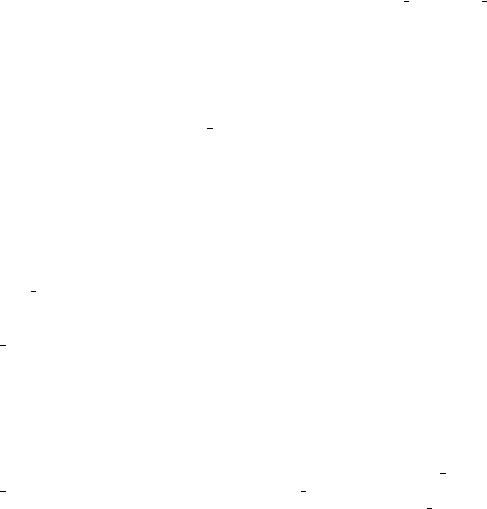
200 |
CHAPTER 9. NEURAL NETWORK MODELS AND FUNCTIONS |
Horizontal size Since the internal representation of a network doesn't allow to determine the 2-dimensional layout of the grid, the horizontal size in units must be provided for the learning function. It is the same value as used for the creation of the network.
Note: After each completed training the parameters adaption height and adaption radius are updated in the control panel to re ect their new values. So when training is started anew, it resumes at the point where it was stopped last. Both mult H and mult R should be in the range (0 1]. A value of 1 consequently keeps the adaption values at a constant level.
9.14.2.2The Kohonen Update Function
A special update function (Kohonen Order) is also provided in SNNS. This function has to be used since it is the only one that takes care of the special ordering of units in the competitive layer. If another update is selected an \Error: Dead units in the network" may occur when propagating patterns.
9.14.2.3The Kohonen Init Function
Before a SOM can be trained, its weights have to be initialized using the init function Kohonen Weights. This init function rst initializes all weights with random values between the speci ed borders. Then it normalizes all links on a per-unit basis. Some of the internal values needed for later training are also set here. It uses the same parameters as CPN Weights (see section 9.6.2).
9.14.2.4The Kohonen Activation Functions
The Kohonen learning algorithm does not use the activation functions of the units. Therefore it is basically unimportant which activation function is used in the SOM. For display and evaluation reasons, however, the two activation functions Act Component and Act Euclid have been implemented in SNNS. Act Euclid copies the Euclidian distance of the unit from the training pattern to the unit activation, while Act Component writes the weight to one speci c component unit into the activation of the unit.
9.14.2.5Building and Training Self-Organizing Maps
Since any modi cation of a Self-Organizing Map in the 2D display like the creation, deletion or movement of units or weights may destroy the relative position of the units in the map we strongly recommend to generate these networks only with the available BIGNET (Kohonen) tool. See also chapter 7 for detailed information on how to create networks. Outside xgui you can also use the tool convert2snns. Information on this program can be found in the respective README le in the directory SNNSv4.2/tools/doc. Note:
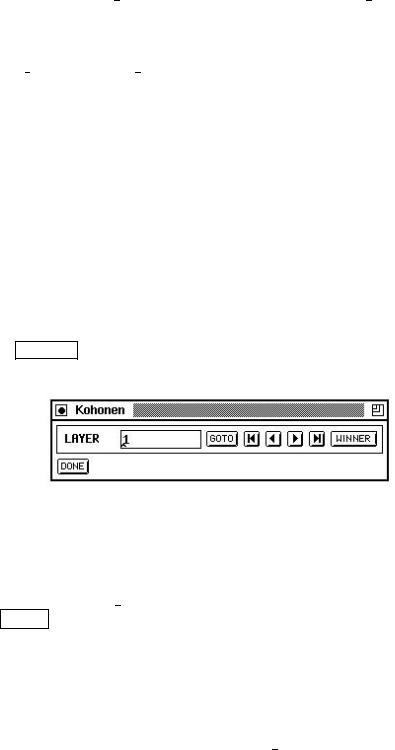
9.14. SELF-ORGANIZING MAPS (SOMS) |
201 |
Any modi cation of the units after the creation of the network may result in undesired behavior!
To train a new feature map with SNNS, set the appropriate standard functions: select init function KOHONEN Weights, update function Kohonen Order and learning function Kohonen. Remember: There is no special activation function for Kohonen learning, since setting an activation function for the units doesn't a ect the learning procedure. To visualize the results of the training, however, one of the two activation functions Act Euclid and Act Componnent has to be selected. For their semantics see section 9.14.2.6.
After providing patterns (ideally normalized) and assigning reasonable values to the learning function, the learning process can be started. To get a proper appearance of SOMs in the 2D-display set the grid width to 16 and turn o the unit labeling and link display in the display panel.
When a learning run is completed the adaption height and adaption radius parameters are automatically updated in the control panel to re ect the actual values in the kernel.
9.14.2.6Evaluation Tools for SOMs
When the results of the learning process are to be analyzed, the tools described here can be used to evaluate the qualitative properties of the SOM. In order to provide this functionality, a special panel was added. It can be called from the manager panel by clicking the KOHONEN button and is displayed in gure 9.13. Yet, the panel can only be used in combination with the control panel.
Figure 9.13: The additional KOHONEN (control) panel
1.Euclidian distance
The distance between an input vector and the weight vectors can be visualized using a distance map. This function allows using the SOM as a classi er for arbitrary input patterns: Choose Act Euclid as activation function for the hidden units, then use the TEST button in the control panel to see the distance maps of consecutive patterns. As green squares (big lled squares on B/W terminals) indicate high activations, green squares here mean big distances, while blue squares represent small distances. Note: The input vector is not normalized before calculating the distance to the competitive units. This doesn't a ect the qualitative appearance of the distance maps, but o ers the advantage of evaluating SOMs that were generated by di erent SOM-algorithms (learning without normalization). If the dot product as similarity measure is to be used select Act Identity as activation function for the hidden units.

202 |
CHAPTER 9. NEURAL NETWORK MODELS AND FUNCTIONS |
2.Component maps
To determine the quality of the clustering for each component of the input vector use this function of the SOM analyzing tool. Due to the topology-preserving nature of the SOM algorithm, the component maps can be compared after printing, thereby detecting correlations between some components: Choose the activation function Act Component for the hidden units. Just like displaying a pattern, component maps can be displayed using the LAYER buttons in the KOHONEN panel. Again, green squares represent large, positive weights.
3.Winning Units
The set of units that came out as winners in the learning process can also be displayed in SNNS. This shows the distribution of patterns on the SOM. To proceed, turn on units top in the setup window of the display and select the winner item to be shown. New winning units will be displayed without deleting the existing, which enables tracing the temporal development of clusters while learning is in progress. The display of the winning units is refreshed by pressing the WINNER button again.
Note: Since the winner algorithm is part of the KOHONEN learning function, the learning parameters must be set as if learning is to be performed.
9.15Autoassociative Networks
9.15.1General Characteristics
Autoassociative networks store single instances of items, and can be thought of in a way similar to human memory. In an autoassociative network each pattern presented to the network serves as both the input and the output pattern. Autoassociative networks are typically used for tasks involving pattern completion. During retrieval, a probe pattern is presented to the network causing the network to display a composite of its learned patterns most consistent with the new information.
Autoassociative networks typically consist of a single layer of nodes with each node representing some feature of the environment. However in SNNS they are represented by two layers to make it easier to compare the input to the output. The following section explains the layout in more detail12.
Autoassociative networks must use the update function RM Synchronous and the initialization function RM Random Weights. The use of others may destroy essential characteristics of the autoassociative network. Please note, that the update function RM Synchronous needs as a parameter the number of iterations performed before the network output is computed. 50 has shown to be very suitable here.
All the implementations of autoassociative networks in SNNS report error as the sum of squared error between the input pattern on the world layer and the resultant pattern on
12For any comments or questions concerning the implementation of an autoassociative memory please refer to Jamie DeCoster at jamie@psych.purdue.edu
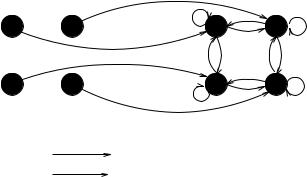
9.15. AUTOASSOCIATIVE NETWORKS |
203 |
the learning layer after the pattern has been propagated a user de ned number of times.
9.15.2Layout of Autoassociative Networks
An autoassociative network in SNNS consists of two layers: A layer of world units and a layer of learning units. The representation on the world units indicates the information coming into the network from the outside world. The representation on the learning units represents the network's current interpretation of the incoming information. This interpretation is determined partially by the input and partially by the network's prior learning.
Figure 9.14 shows a simple example network. Each unit in the world layer sends input to exactly one unit in the learning layer. The connected pair of units corresponds to a single node in the typical representation of autoassociative networks. The link from the world unit always has a weight of 1.0, and is unidirectional from the world unit to the learning unit. The learning units are fully interconnected with each other.
World Units |
Learning Units |
Trainable links
Links with fixed weight 1.0
Figure 9.14: A simple Autoassociative Memory Network
The links between the learning units change according to the selected learning rule tot the representation on the world units. The links between the world units and their corresponding learning units are not a ected by learning.
9.15.3Hebbian Learning
In Hebbian learning weights between learning nodes are adjusted so that each weight better represents the relationship between the nodes. Nodes which tend to be positive or negative at the same time will have strong positive weights while those which tend to be opposite will have strong negative weights. Nodes which are uncorrelated will have weights near zero.
The general formula for Hebbian learning is
wij = n inputi inputj

204 |
CHAPTER 9. NEURAL NETWORK MODELS AND FUNCTIONS |
where:
nis the learning rate
inputi is the external input to node i inputj is the external input to node j
9.15.4McClelland & Rumelhart's Delta Rule
This rule is presented in detail in chapter 17 of [RM86]. In general the delta rule outperforms the Hebbian learning rule. The delta rule is also less likely so produce explosive growth in the network. For each learning cycle the pattern is propagated through the network ncycles (a learning parameter) times after which learning occurs. Weights are updated according to the following rule:
wij = n di aj
where:
nis the learning rate
aj is the activation of the source node di is the error in the destination node.
This error is de ned as the external input - the internal input.
In their original work McClelland and Rumelhart used an unusual activation function:
for unit i,
if neti > 0
delta ai = E * neti * (1 - ai) - D * ai else
delta ai = E * neti * (ai + 1) - D * ai
where:
neti is the net input to i (external + internal)
E is the excitation parameter (here set to 0.15)
Dis the decay parameter (here set to 0.15)
This function is included in SNNS as ACT RM. Other activation functions may be used in its place.
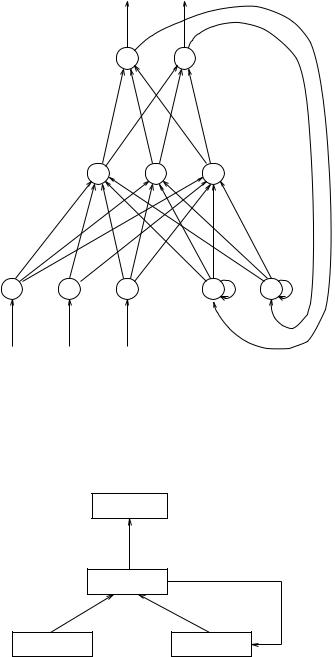
9.16. PARTIAL RECURRENT NETWORKS |
205 |
9.16Partial Recurrent Networks
9.16.1Models of Partial Recurrent Networks
9.16.1.1Jordan Networks
output units
hidden units
input |
units |
state |
|
units |
|||
|
|
Figure 9.15: Jordan network
Literature: [Jor86b], [Jor86a]
9.16.1.2Elman Networks
output units
|
hidden units |
|
1.0 |
input units |
context units |
Figure 9.16: Elman network
Literature: [Elm90]
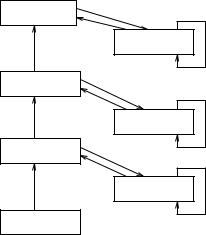
206 |
CHAPTER 9. NEURAL NETWORK MODELS AND FUNCTIONS |
9.16.1.3Extended Hierarchical Elman Networks
output layer |
1.0 |
|
|
context layer 3 |
γ |
|
|
3 |
hidden layer 2 |
1.0 |
|
|
context layer 2 |
γ 2 |
hidden layer 1 |
1.0 |
|
|
context layer 1 |
γ 1 |
|
|
|
input layer |
|
|
Figure 9.17: Extended Elman architecture
9.16.2Working with Partial Recurrent Networks
In this subsection, the initialization, learning, and update functions for partial recurrent networks are described. These functions can not be applied to only the three network models described in the previous subsection. They can be applied to a broader class of partial recurrent networks. Every partial recurrent network, that has the following restrictions, can be used:
If after the deletion of all context units and the links to and from them, the remaining network is a simple feedforward architecture with no cycles.
Input units must not get input from other units.
Outputunits. units may only have outgoing connections to context units, but not to other
Every unit, except the input units, has to have at least one incoming link. For a context unit this restriction is already ful lled when there exists only a self recurrent link. In this case the context unit receives its input only from itself.
In such networks all links leading to context units are considered as recurrent links.
Thereby the user has a lot of possibilities to experiment with a great variety of partial recurrent networks. E.g. it is allowed to connect context units with other context units.
Note: context units are realized as special hidden units. All units of type special hidden are assumed to be context units and are treated like this.

9.16. PARTIAL RECURRENT NETWORKS |
207 |
9.16.2.1The Initialization Function JE Weights
The initialization function JE Weights requires the speci cation of ve parameters:
, : The weights of the forward connections are randomly chosen from the interval [ ].
: Weights of self recurrent links from context units to themselves. Simple Elman networks use = 0.
1:0. : Weights of other recurrent links to context units. This value is often set to
: Initial activation of all context units.
These values are to be set in the INIT line of the control panel in the order given above.
9.16.2.2Learning Functions
By deleting all recurrent links in a partial recurrent network, a simple feedforward network remains. The context units have now the function of input units, i.e. the total network input consists of two components. The rst component is the pattern vector, which was the only input to the partial recurrent network. The second component is a state vector. This state vector is given through the next{state function in every step. By this way the behavior of a partial recurrent network can be simulated with a simple feedforward network, that receives the state not implicitly through recurrent links, but as an explicit part of the input vector. In this sense, backpropagation algorithms can easily be modi ed for the training of partial recurrent networks in the following way:
1.Initialization of the context units. In the following steps, all recurrent links are assumed to be not existent, except in step 2(f).
2.Execute for each pattern of the training sequence the following steps:
input of the pattern and forward propagation through the network
calculation of the error signals of output units by comparing the computed output and the teaching output
back propagation of the error signals
calculation of the weight changes
only on{line training: weight adaption
calculation of the new state of the context units according to the incoming links
3.Only o {line training: weight adaption
In this manner, the following learning functions have been adapted for the training of partial recurrent networks like Jordan and Elman networks:
JE BP: Standard Backpropagation for partial recurrent networks
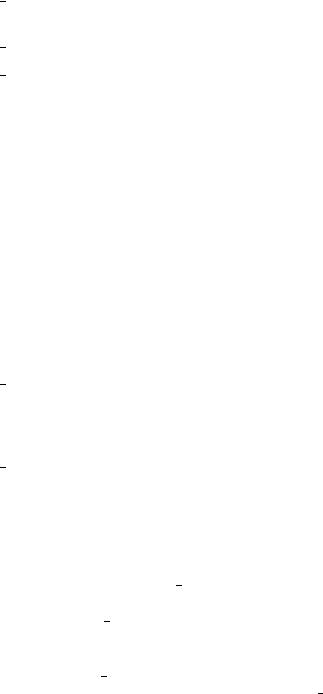
208 |
CHAPTER 9. NEURAL NETWORK MODELS AND FUNCTIONS |
JE BPMomentum: Standard Backpropagation with Momentum{Term for partial recurrent networks
JE Quickprop: Quickprop for partial recurrent networks
JE Rprop: Rprop for partial recurrent networks
The parameters for these learning functions are the same as for the regular feedforward versions of these algorithms (see section 4.4) plus one special parameter.
For training a network with one of these functions a method called teacher forcing can be used. Teacher forcing means that during the training phase the output units propagate the teaching output instead of their produced output to successor units (if there are any). The new parameter is used to enable or disable teacher forcing. If the value is less or equal 0.0 only the teaching output is used, if it is greater or equal 1.0 the real output is propagated. Values between 0.0 and 1.0 yield a weighted sum of the teaching output and the real output.
9.16.2.3Update Functions
Two new update functions have been implemented for partial recurrent networks:
JE Order:
This update function propagates a pattern from the input layer to the rst hidden layer, then to the second hidden layer, etc. and nally to the output layer. After this follows a synchronous update of all context units.
JE Special:
This update function can be used for iterated long-term predictions. If the actual
prediction value pi is part of the next input pattern inpi+1 to predict the next value pi+1, the input pattern inpi+1 can not be generated before the needed prediction value pi is available. For long-term predictions many input patterns have to be generated in this manner. To generate these patterns manually means a lot of e ort.
Using the update function JE Special these input patterns will be generated dynamically. Let n be the number of input units and m the number of output units of the network. JE Special generates the new input vector with the output of the
last n ; m input units and the outputs of the m output units. The usage of this update function requires n > m. The propagation of the new generated pattern is done like using JE Update. The number of the actual pattern in the control panel has no meaning for the input pattern when using JE Special.
9.17 Stochastic Learning Functions
The monte carlo method and simulated annealing are widely used algorithms for solving any kind of optimization problems. These stochastic functions have some advantages over other learning functions. They allow any net structure, any type of neurons and any type
